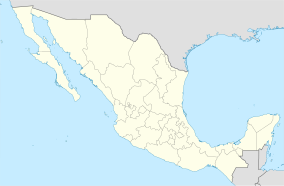| Chamela-Cuixmala Biosphere Reserve | |
|---|---|
 View north over tropical dry forest within Chamela-Cuixmala | |
| Area | 131.42 km2 (50.74 sq mi)[2] |
| Designation | Biosphere reserve |
| Designated | 1994 (national) 2006 (international) |
| Administrator | National Commission of Natural Protected Areas and National Autonomous University of Mexico |
| Official name | Reserva de la Biosfera Chamela-Cuixmala |
| Designated | 2 February 2004 |
| Reference no. | 1334[3] |
The Chamela-Cuixmala Biosphere Reserve is a biosphere reserve on the Pacific coast of the Mexican state of Jalisco. The park was founded in 1993 and covers 131.42 square kilometres in La Huerta Municipality. The land is mountainous and contains dry tropical forest and rolling hills and alluvial plains.

Wildlife
[edit]
Wildlife includes the jaguar, puma,[4] ocelot, jaguarundi, coyote, coati, armadillo, skunk, white tailed deer, peccary, American crocodile, geckos, potoos, hawks, kites, storks, vultures, boas, vipers, coral snakes, toads, frogs, sea turtles, opossums, macaws, and woodpeckers. In addition, the Pacific Slope region of Mexico and the reserve itself supports a high diversity of neotropical migratory bird species during the winter.
Protection
[edit]An area of 63.23 km2 was designated a biosphere reserve in 1994 by the Mexican government. This area, also known as the core zone (zona nucleo), is managed as a strict nature reserve.[1] The UNESCO biosphere reserve, designated in 2006, encompasses an area of 131.42 km2 which overlaps the national biosphere reserve, and extends into Chamela Bay and its islands. The UNESCO reserve includes a larger core area of 82.08 km2, buffer areas of 49.342, and transitional areas of 12.16 km2.[5]
Both the National Autonomous University of Mexico (UNAM) and the Cuixmala Ecological Foundation, A.C, own most of the land in the reserve. The reserve is threatened by development projects in bordering tracts.
Biological Station UNAM
[edit]In 1971, the Biology Institute of the National Autonomous University of Mexico, built a research station.[6]
The main objectives were:
- Preserve the surrounding ecosystems.
- Study the ecosystems structure and function.
- Offer services that help develop investigation and science communication.
References
[edit]- ^ a b UNEP-WCMC (2022). Protected Area Profile for Chamela-Cuixmala from the World Database on Protected Areas. Accessed 16 August 2022. [1]
- ^ UNEP-WCMC (2022). Protected Area Profile for Chamela-Cuixmala from the World Database on Protected Areas. Accessed 16 August 2022. [2]
- ^ "Reserva de la Biosfera Chamela-Cuixmala". Ramsar Sites Information Service. Retrieved 25 April 2018.
- ^ Rodrigo Nuanaez; Brian Miller; Fred Lindzey (2000). "Food habits of jaguars and pumas in Jalisco, Mexico". Journal of Zoology. 252 (3): 373–379. doi:10.1111/j.1469-7998.2000.tb00632.x. Retrieved 2006-08-08.
- ^ Chamela Cuixmala Biosphere Reserve, Mexico. UNESCO, October 2018. Accessed 16 August 2022.
- ^ "ESTACION CHAMELA". www.ibiologia.unam.mx. Retrieved 2016-01-08.

